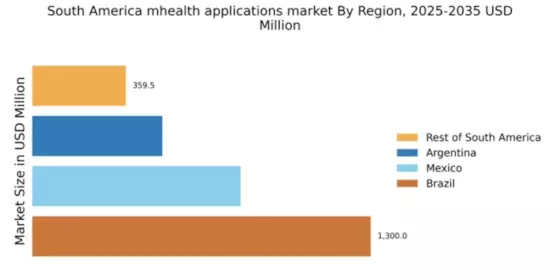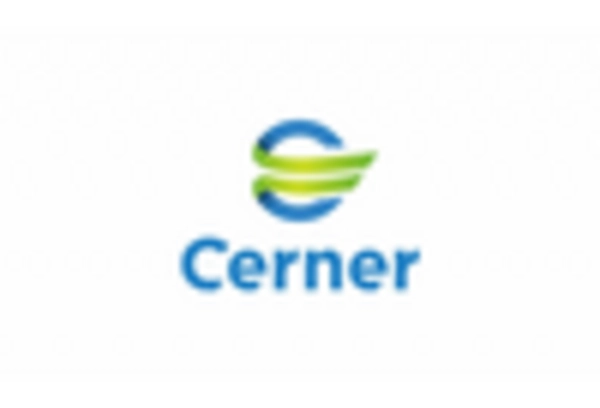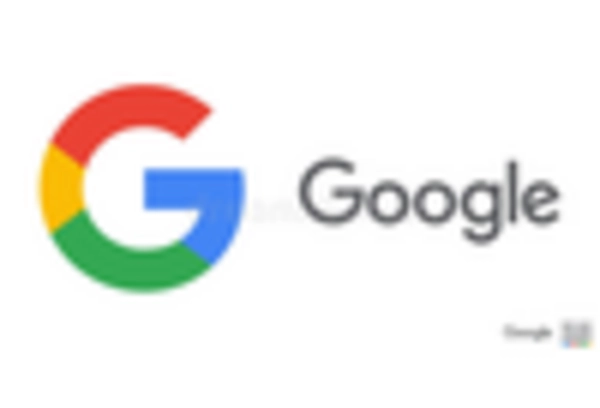Growing Health Awareness
Rising health consciousness among the South American population is a crucial driver for the mhealth applications market. As individuals become more aware of health issues and the importance of preventive care, the demand for mobile health solutions is increasing. Surveys indicate that over 60% of South Americans are actively seeking ways to improve their health through technology. This trend is reflected in the growing number of downloads for health-related applications, which has surged by 25% in the past year. Users are increasingly utilizing mhealth applications for fitness tracking, dietary management, and mental health support. This heightened awareness and proactive approach to health management are expected to propel the mhealth applications market forward, as more individuals turn to technology for health solutions.
Rising Smartphone Penetration
Increasing smartphone penetration in South America is a pivotal driver for the mhealth applications market. As of 2025, smartphone usage in the region has reached approximately 80%, facilitating access to various health applications. This trend indicates that more individuals are likely to utilize mobile health solutions for managing their health. The proliferation of affordable smartphones has made it easier for users to download and engage with mhealth applications, thereby enhancing user engagement. Furthermore, the availability of mobile internet services has improved connectivity, allowing users to access real-time health information and services. This growing smartphone adoption is expected to continue driving the mhealth applications market, as more users seek convenient and efficient ways to monitor their health and wellness.
Integration of Wearable Devices
Integration of wearable devices with mhealth applications is emerging as a significant driver in South America. As wearable technology becomes more sophisticated and affordable, users are increasingly adopting devices that monitor various health metrics, such as heart rate, activity levels, and sleep patterns. In 2025, it is projected that the market for wearable health devices in the region will grow by 40%, further enhancing the functionality of mhealth applications. This synergy between wearables and mobile applications allows for real-time health monitoring and personalized feedback, which can lead to improved health outcomes. The growing trend of fitness and wellness among consumers is likely to continue driving the mhealth applications market as users seek to leverage technology for better health management.
Increased Focus on Mental Health
The growing emphasis on mental health awareness in South America is significantly impacting the mhealth applications market. As societal attitudes towards mental health evolve, there is a rising demand for mobile applications that provide mental health support and resources. In 2025, it is estimated that the usage of mental health apps has increased by 50%, reflecting a shift in consumer priorities. These applications offer various services, including therapy sessions, mindfulness exercises, and stress management tools, catering to a diverse audience. The increasing recognition of mental health as a critical component of overall well-being is likely to drive further growth in the mhealth applications market, as more individuals seek accessible and convenient solutions for mental health care.
Government Initiatives and Support
Government initiatives aimed at promoting digital health solutions are significantly influencing the mhealth applications market in South America. Various countries in the region have launched programs to enhance healthcare accessibility through technology. For instance, investments in digital infrastructure and incentives for app developers are becoming more common. In 2025, it is estimated that government funding for health technology projects has increased by 30%, reflecting a commitment to integrating mhealth solutions into public health strategies. These initiatives not only foster innovation but also encourage collaboration between public and private sectors, thereby expanding the reach of mhealth applications. As governments continue to prioritize digital health, the mhealth applications market is likely to experience substantial growth.


















Leave a Comment